Medical sign. Snake, Bowl and Staff: The Origin of Medical Symbols
What living creature is associated with medicine? Of course the snake wrapping around the cup. Meanwhile, the poisonous reptile was not always the only medical emblem. There have been and still are many alternative symbols.
Great and terrible
Snake hypostasis of the ancient Egyptian goddess Isis
Snakes have been worshiped at all times and in all corners of the earth. In the myths of Babylon and Assyria, these reptiles reigned in prehistoric times. Snakehead gods were in many pantheons, well, and scaled companion was one of the most frequent satellites of higher powers.
“There is a great serpent; he is the king of the land of Ethiopia; All the rulers bow to him and offer him a beautiful maiden. Having decorated her, they lead this snake before and leave it alone, and this snake devours it ... The length of this snake is 170 cubits, and the thickness is 4; his teeth are as long as his elbow, and his eyes are like a flame of fire, his eyebrows are black as a raven, and the whole look is like tin and copper ... On it is a horn three cubits. When he moves, the noise is heard for seven days' journey. ”
From the Abyssinian legend
Snakes were considered immortal - after all, they are able to periodically shed their skin, that is, be renewed. Many myths agree that this gift was originally intended for people, but either sly reptiles stole it, as in Sumerian legends, or the person himself refused the heavy burden of eternal life in favor of creeping reptiles, as in the Greek myth.
In the ancient world, snakes were very closely intertwined with medicine. So, it was the serpent, according to Greek mythology, which brought Asclepius to the idea of the possibility of raising the dead. Once he was invited to the palace of the Cretan ruler of Minos to resurrect the deceased prince. On his staff, Asclepius suddenly saw the serpent and killed it. Immediately another snake appeared with a healing herb in its mouth and resurrected the dead one. The future god took advantage of this grass and raised the dead.
The snake wraps around the body of Isis, the patroness of healing in ancient Egypt, the cobra is one of the hypostasis of the goddess. The same symbol decorated the field kit of the military doctor of the Roman army. On the one hand, people wanted in this way to appease the formidable forces of nature, on the other hand, using the sinister look of a snake, to frighten off diseases.
Fateful vessel

Another component of the traditional medical emblem - the bowl - also has an ancient origin. In the desert terrain it was extremely important to catch the life-giving moisture sent from heaven, and for this purpose large metal bowls were used. It is this holds in the hands, asking for help from the gods, the patient, depicted on the ancient Egyptian stele.
Water was an essential part of any treatment. Healing plots and spells are often cut or minted directly on the vessels. The expressions “the cup of life”, “the cup of patience”, “drink the cup to the bottom”, “the house full cup”, which show how this everyday utensil was important for the ancestors, have survived to this day.
Different bowls carried a different symbolic meaning. For example, a double or a double reflects a human nature’s nature, a positive and a negative, a heavenly and terrestrial component, sublime and base aspirations. That is why in medicine a bowl without a second bottom took root, a Greek phial without a stand. She is often portrayed in the hands of daughters (and according to another version - and wives in general) of Asclepius - Hygiea and Panakei.
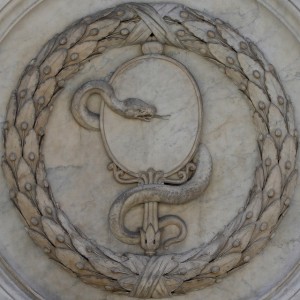
The bowl is also directly related to snakes: their poison was collected and stored mainly in such dishes. It also mixed teriaki - ancient and medieval universal antidotes. Up until the 20th century, pharmacists used copper or brass bowls.
One of the rare variants of the emblem is a snake wrapped around the handle of the mirror. It protects the surface of human consciousness, which keeps reflections of previous millennia. Apparently, therefore, the International Society for the History of Medicine chose such an unusual symbol for itself in 1980.
The symbol, but not the one

If you look closely at the emblem of the World Health Organization, which was approved at the I Assembly in Geneva in 1948, you will notice that there is not a cup around the snake, but a staff. Why did it happen? Where did this attribute come from?
This is the staff of Asclepius. The one with whom one serpent was killed and onto which the second climbed, who came to resurrect it. This symbol contains a large number of other values. For example, it is most often depicted as a gnarled stick, which means communication with the earth and nature. In addition, the staff is a symbol of wandering, namely, in traveling, ancient doctors acquired their knowledge and skills. In addition, if the doctor relied on something while walking, it means that he was wise not only for years, but also for experience. And it was precisely such a doctor that was trusted the most.
In the Middle Ages and in the Renaissance, the staff transformed into a medical cane, and in some cases into a medical sword, which, for example, was in Paracelsus. Often in the upper part there was a secret medicine, a unique antidote, or simply vinegar, used to prevent infection from the patient. The tradition disappeared only by the middle of the 20th century, and the staff became a symbol of medicine in Europe.

By the way, on the staff of Asclepius there can be not one serpent, but two. But the story of another emblem is much more interesting, when the staff is shorter, the snakes are always two, and there are still wings at the top. Caduceus, the staff of the heralds, as well as the indispensable tool of the god Hermes (Mercury), capable of reconciling even the most ardent opponents. The common medical symbol of caduceus became in the Renaissance.
There is a version, this is due to the fact that in the XVI century alchemy began to develop, the patron saint of which was considered Hermes. The main goal of alchemical experiments at that time was no longer the search for a philosopher's stone, but the obtaining of medicines. On vessels with drugs, alchemists usually stamped with Hermes. As an emblem of doctors, caduceus was entrenched, for example, in the United States of America. But there is another version: the caduceus was simply mistaken for Asclepius’s another staff, since they are similar. Is there anything wrong fixed in our lives? Here is the rod of Hermes - approximately from the same opera.

Well, the classic snake with a cup caught on mainly in the territory of the former USSR. In modern Russia, it was not without modifications, for example, on the current emblem of the Military Medical Academy, two snakes are shown twisting the bowl in opposition to each other (see figure above).
Other

Asclepius and rooster. Statue of Asclepius with a dog lying at his feet in Asklepione
For a long time, owl, rooster, raven, and dog were considered to be full and equal symbols of medicine. All of them at different times depicted next to Asclepius. The owl and the raven were considered a symbol of wisdom, without which the doctor can not do. The dog is the personification of loyalty and devotion, the desire to serve and protect. The raven from this company lasted the longest, medieval alchemists tagged him with their medications.
An interesting interpretation of the role of the rooster: first of all, he was just a sacrificial food, his blood was intended for Asclepius, and the meat, to which the healing properties were attributed, was sick. With the advent of Christianity, another interpretation emerged: the rooster’s cry chases away the evil spirits, welcomes the coming of the morning, when it becomes easier for most patients.
“How pleasant is the song of the rooster at night. And not only pleasant, but also useful. Everybody gives hope in the heart of this cry; patients feel relieved, pain in wounds is reduced: with the advent of light the fever heat subsides "
Ambrose of Milan (III cent.)
Often the rooster was depicted paired with a snake, in this case they personified two key qualities of the doctor: vigilance and caution. Sometimes on ancient bas-reliefs Asclepius is accompanied by a goat. Her image recalls that, according to Greek mythology, the goat Athena fed Asclepius the baby with milk. That is why in asclepion usually bulls, pigs and rams were sacrificed, but goats were never among the sacrificial animals.
In the 13th century, the images of a staff with a snake and a singing rooster were decorated with the title pages of medical writings. In the Renaissance, medicine was often depicted as a woman (presumably - Hygiea), topped with laurels. In one hand was her staff, entwined with a snake, and in the other - a rooster.
Crosses and stars
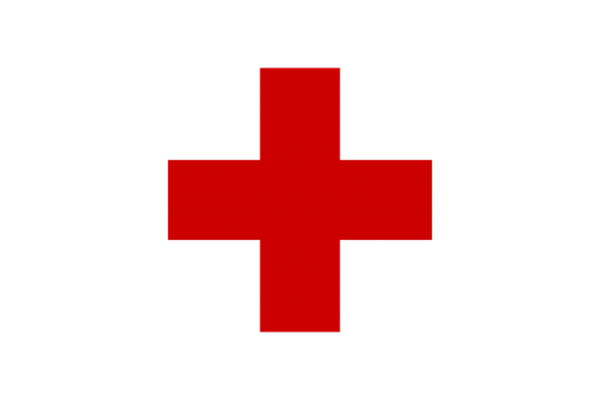 The red cross and the blue six-pointed star can be considered as a modern addition to the arsenal of medical paraphernalia. I think everyone knows the history of the first symbol, so let me remind you only briefly: in 1863, a committee to reduce the suffering of soldiers during wars was created in Geneva, the participants of the founding conference chose the inverted flag of Switzerland as an emblem, without thinking twice. The red cross, originally associated only with the ICRC, got accustomed and became, perhaps, the most common designation of everything medical: it is on specialized medical machines, on the doors of medical institutions, even on first-aid kits in computer games, and a lot more on it.
The red cross and the blue six-pointed star can be considered as a modern addition to the arsenal of medical paraphernalia. I think everyone knows the history of the first symbol, so let me remind you only briefly: in 1863, a committee to reduce the suffering of soldiers during wars was created in Geneva, the participants of the founding conference chose the inverted flag of Switzerland as an emblem, without thinking twice. The red cross, originally associated only with the ICRC, got accustomed and became, perhaps, the most common designation of everything medical: it is on specialized medical machines, on the doors of medical institutions, even on first-aid kits in computer games, and a lot more on it.
However, this is slightly altogether wrong in terms of law. The red cross is an official and protected image, belongs only to the ICRC, and it is used exclusively in wartime. It can be worn by military doctors, military priests, they are marked with means to care for the wounded, including hospital tents, and it is also used to designate an international or national representative of the organization. And that's all. The ICRC, through national committees, is trying to sensitize organizations and people using the red cross to the right and left, sometimes it even reaches the court, so Johnson & Johnson once forcibly took away the red cross trademark.
However, this legal collision has a downside: the protected image is a red cross on a white background. If you change the background or cross color - everything, take who you want, use where you want. So a green cross of pharmacists, a blue cross of veterinarians, etc. appeared. By and large, even the classic red cross, but on a blue, yellow, purple, any other background, is already quite a legal logo.
A very short lyrical digression: if absolutely correct, then the red (though not only red) crosses painted on their clothes the Templar and the Hospitallers, and it is to the latter that we owe to the appearance of the hospitals. Initially, they were peculiar shelters, hotels or something, but gradually they began to talk about the military (first), and then about civilian hospitals. Another thing is that the hospital crosses were different from the Swiss ones, which the ICRC took for itself, but this is a completely different story.
 During the Russian-Turkish war (1876-1878), another official symbol appeared - the red crescent, an option for Muslim countries. The Israelis tried to promote the red Mogend, but the ICRC did not like this idea. After long disputes in 2005, a special ICRC symbol, a red crystal, an equilateral diamond on a white background, was adopted at a special conference by two thirds of the votes.
During the Russian-Turkish war (1876-1878), another official symbol appeared - the red crescent, an option for Muslim countries. The Israelis tried to promote the red Mogend, but the ICRC did not like this idea. After long disputes in 2005, a special ICRC symbol, a red crystal, an equilateral diamond on a white background, was adopted at a special conference by two thirds of the votes.
 The fact is that by that time there was a huge mass of applications for international recognition of national and / or religious emblems in red: here is the Siamese red flame, and the Persian red sun, and the red wheel with a swastika, and the red Lebanese cedar, and the red Sudanese rhino , and the red Syrian palm and even the red star claimed from Zimbabwe. The ICRC considered that such diversity destroys the very idea of a universal single symbol, which can be used as a guardian in any war. Three will suffice, the ICRC said: the cross is for Christians, the crescent is for Muslims, the rest will be killed by crystal, there is nothing for the essence to multiply.
The fact is that by that time there was a huge mass of applications for international recognition of national and / or religious emblems in red: here is the Siamese red flame, and the Persian red sun, and the red wheel with a swastika, and the red Lebanese cedar, and the red Sudanese rhino , and the red Syrian palm and even the red star claimed from Zimbabwe. The ICRC considered that such diversity destroys the very idea of a universal single symbol, which can be used as a guardian in any war. Three will suffice, the ICRC said: the cross is for Christians, the crescent is for Muslims, the rest will be killed by crystal, there is nothing for the essence to multiply.
The MOE nicknames swallowed the pill, took off the crosses, and in their place put a blue star about six rays, and these rays are the main tasks that rescuers and paramedics solve: detection, communication with experts, response, assistance in the field, transportation assistance, delivery in hospitals. The star was patented in 1977, the logo of the American Medical Association was taken as the basis for its development. In 1997, the term of patent protection expired, and today very many “Ambulances” around the world carry the “Star of Life” on their boards - from Peru to Poland and from Sweden to Italy. It is noteworthy that inside the blue star there is a regular staff, classic, long, with one snake and without wings.
P.S. I do not pretend to comprehensive coverage, it is possible that I missed something important.
A strongly abbreviated version of the article was published in the journal Russian Pharmacies, 2013, No. 24
Back in the days when the social order of mankind was extremely primitive and was in its infancy, the first steps were taken to create a modern symbol of medicine. In ancient beliefs, snakes became the main symbol of healing, duality was attributed to them. On the one hand, these creatures were insidious and cunning, and on the other, they were wisdom, knowledge, immortality and proper nutrition. Interestingly, all these qualities, mainly related to simple snakes, which are also called "Eskulapovy." In the homes of the ancient Greeks and Romans, these creatures felt quite comfortable; they were cared for, fed, and could move freely around the house. It is known that snakes often licked their wounds. Somewhat later, to the symbolism of the snake, they began to add a bowl, occasionally a staff, around which a reptile was twined. So the symbol of medicine was born the bowl with a snake.
Important role in the formation of the symbol of the bowl with a snake played ancient Greek myths. For example, the great healer Asclepius (in the Roman mythology Esculapius) was always depicted next to snakes. According to legend, he was summoned by the king of Minos to revive his son. On the way Asclepius remarked that from the cane that had served him as a support, a snake was beginning to crawl out. Fear took hold of him, and he quickly killed her. After a moment, another snake crawled out of the grass, with a bundle of some grass in its mouth, with the help of which it was able to revive the dead relative, and they crawled away. Medic took it as a sign and began to look for this herb. Finding her, he was able to subsequently successfully resurrect the son of the king. This was the reason for which Zeus himself decided to kill him, because he feared that because of him people would become immortal. Thus, the snake firmly took root in ancient culture. The first images with a snake around the bowl began to appear even XI BC. e. Other, equally well-known symbols were used, for example:
- snake, studding the staff (thanks to the myths of Asclepius);
- a snake twisting the tripod of Apollo;
- pentagram, later recognized by Christians as heresy and replaced by the image of a hand with fingers splayed.
Snakes have also become a symbol of eternal youth, due to their ability to "shed", removing old skin. Even in ancient Africa, these reptiles were considered curative and were associated with sorcerers, as only they knew how to subject them to their will.
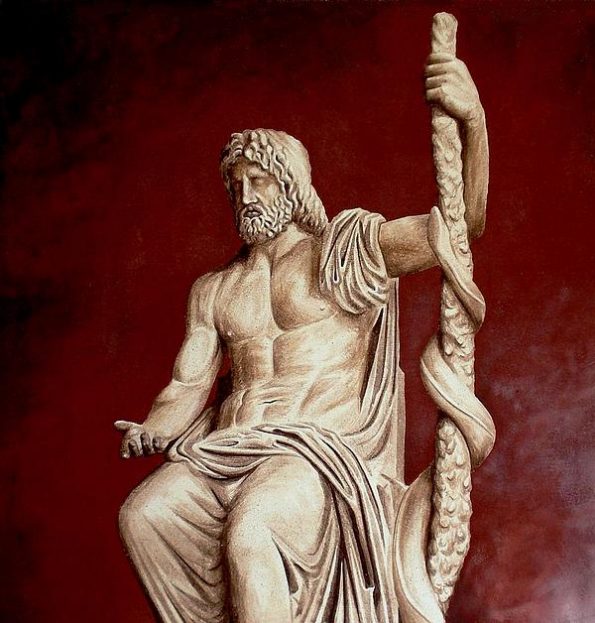
People always perceived the cup as something good and salutary, since it was possible to store fresh water in it. This was especially true for drylands, where, due to rare rains, water was often taken for the gift of heaven. Even in Christianity there is a reflection of this - the cup of the sacrament, a cup that can save a person from his sins.
It is a curious fact that initially the cup was not a separate attribute of healing and, according to mythology, belonged to Guigay, the daughter of Asclepius. She always holds a snake in one hand and a bowl in the other. Subsequently, this symbol was combined into one, which gave rise to numerous disputes among historians.
The interpretation of the cup varies greatly, depending on the source, it can be both a repository for the poison used for treatment, and serve as a reminder that the doctor must be wise and draw his knowledge from the cup of world knowledge, which is, in fact, an allegory on the human mind, who declared the whole world.
The Hippocratic Cup appeared only in the XIII century, becoming the official symbol of medicine. However, no documents that can confirm this have survived to this day.
The most positive interpretation of its symbol was given by medical students. According to their version, the doctor is cunning, like a snake, and is also always happy to drink, which is what the cup symbolizes.
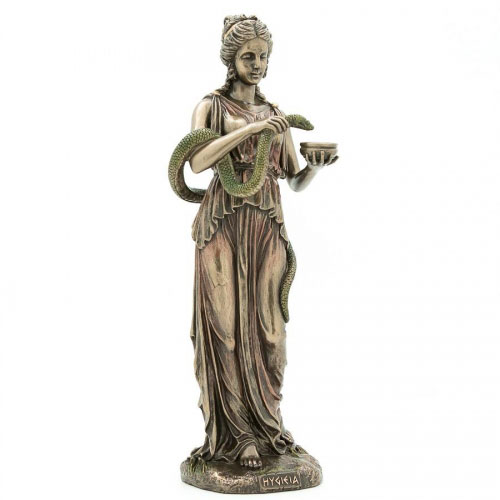
Conclusion
In the modern world, the symbol of medicine is a bowl with a snake, quite often used by pharmaceutical companies, but it can also be seen in military medicine. This is one of the most recognizable symbols of modern times. Its appearance is quite logical, largely due to the culture of the ancient Greeks and Romans, which spread to almost all of Eurasia. Because of this, ancient medicine was able to rise quite high, and healers began to enjoy even more respect.
EMBLEMS are medical (Greek emblema inset, convex decoration) - images symbolizing medicine in general, belonging to the medical profession, various areas and areas of medicine, individual medical specialties.
Fig. 1. The Sumerian stone vase (Gudea's cup), dedicated to the god of healing Ningishzide, with the image of a dragon holding a staff, and a snake (22 century BC).

Fig. 2. Statue of the ancient god of medicine Asclepius with a staff twined with a snake.
Throughout the centuries-old development, medicine has had many emblems; some of them have not lost their significance up to the present, while others have become a thing of the past. The XIII International Congress on the History of Science (Moscow, 1971) proposed the classification of medical emblems according to which they are divided into two groups: general and private medical emblems. General medical emblems symbolize medicine in general, private medical emblems designate its individual branches or directions. This classification is conditional as in the history of medicine, certain common emblems became private in time, and, conversely, private emblems acquired the meaning of common ones. The same private emblem in different historical periods and in different countries could symbolize different branches and directions of medicine.
Fig. 3. The statue of the ancient goddess of health Gygey with a bowl and a snake.
The common medical emblems can include various snake images, including in combination with a staff, with a bowl, with a candle, etc., images of a burning torch, lamp, heart on the palm. The most widespread emblems with the image of a snake.
In primitive society, when totemism and animalism evolved, reflecting the helplessness of primitive man to the outside world, the serpent was one of the main totem animals. Since the rise of the serpent cult, she has been credited with a double role - evil and good. On the one hand, the snake was a symbol of cunning and deceit, on the other - immortality, wisdom and knowledge (color tab., Art. 176. Fig. 1 and 2). In the cultural monuments of Mesopotamia (III millennium BC) the snake is depicted on various objects related to the god of fertility and healing Ningishzida (Fig. 1). This is probably one of the first snake images in the history as a medical emblem. As the emblems of medicine, the original snake was depicted without any attributes (Fig. 4). Later images of a snake appeared in combination with various objects. For example, from about the 8th century BC, one of the symbols of medicine is the staff of the god of healing Asclepius (Esculapius) - a blunt stick, around which a snake was draped headfirst (Fig. 2, as well as flowers, table. Art. 170, Fig. 3 ). In one of the ancient Greek myths told. that Asclepius was invited to the palace of Minos - the king of Crete. to resurrect his dead son. On the way, he saw a snake on his staff and killed her, but a second snake appeared with healing herbs in its mouth and resurrected the dead one. Subsequently, Asclepius cured sick people with this grass. The staff of Asclepius should not be confused with caduceus - an attribute of the god of commerce Hermes (Mercury). representing a rod with wings at the top, entwined with two snakes (Fig. 5). In the ancient world, this emblem was not medical. Only from the 15-16th century the caduceus became a symbol of medicine. Since the 19th century, caduceus has been used as the official medical emblem in several countries of America (eg, the USA), Africa, and Asia.
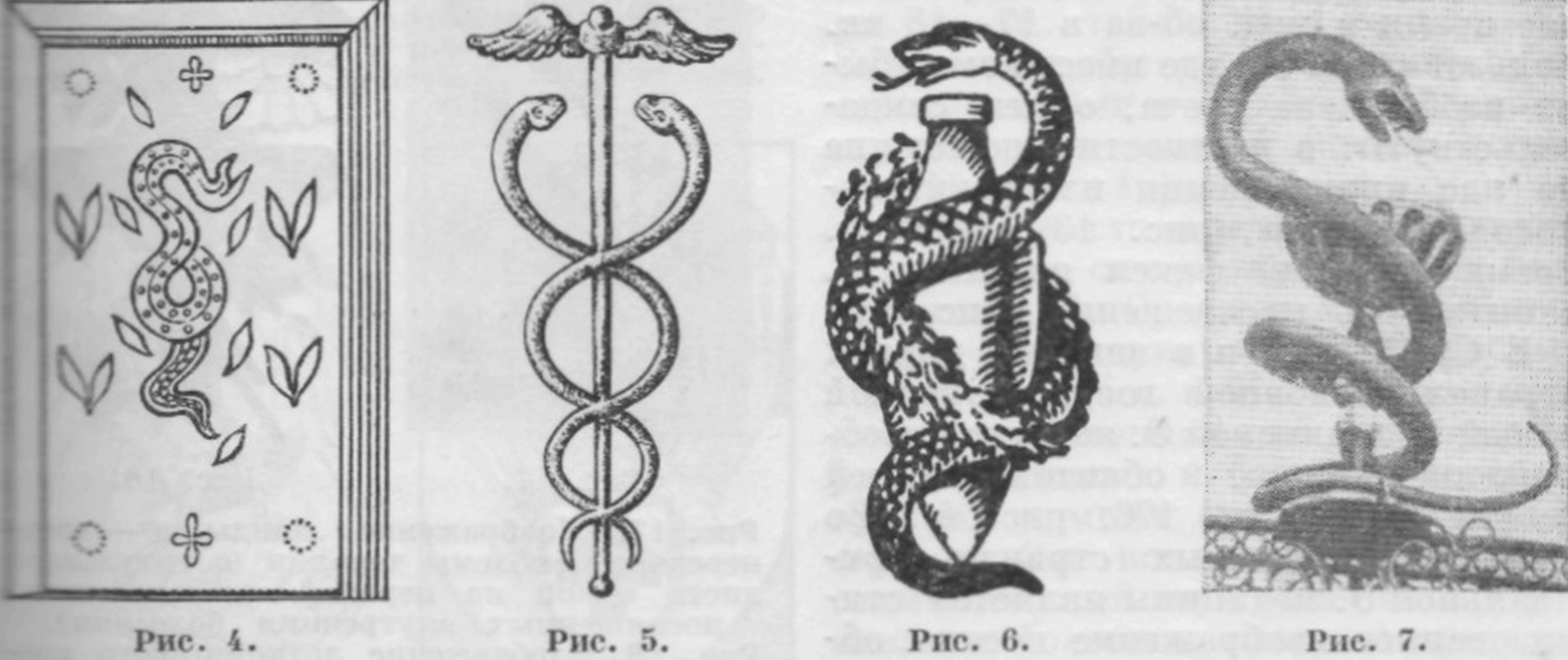
Fig. 4. Antique bronze first-aid kit with a snake. Fig. 5. Caduceus - winged rod entwined with two snakes. Fig. 6. Ancient Greek amphora with a laurel wreath entwined with a snake (from a book-piece that belonged to a medic). Fig. 7. Image of a bowl with a snake on the sign of the Town Hall pharmacy in Tallinn (founded in 1422).
The first images of the bowl with a snake date back to 800-600 BC. The snake and the bowl were depicted separately and were attributes of mainly the goddesses of health Hygea (Fig. 3 and 8) and Saluts (color tab., Art. 176. Fig. 6). Images of an amphora or a bowl entwined with a snake appeared much later (Fig. 6 and 7, as well as the color table., Art. 176, Fig. 5). In the ancient world of the emblem of medicine was not a poisonous snake, but a harmless one.
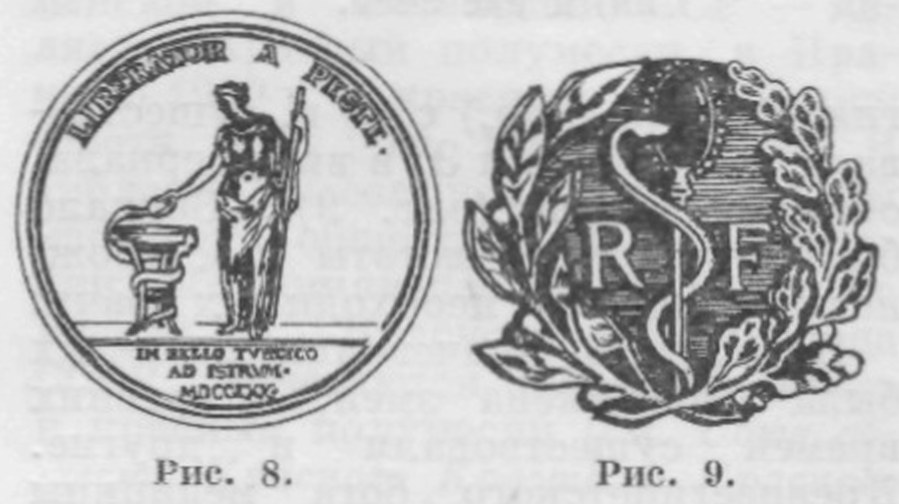
Fig. 8. A commemorative medal dedicated to the fight against the plague, with the image of the tripod Apollo and Hygea entwined with a snake holding a bowl (Russia, 18th century). Fig. 9. Metal badge of French physicians with the image of a mirror entwined with a snake.
![]()
Fig. 10. Ancient Greek coin with the image of Asclepius and two centaurs. holding torches.
The emblem of medicine in the form of the Apollo tripod entwined with a snake is known (Fig. 8). In Europe (France, Belgium, Greece, etc.) from the 18th century there was a medical emblem in the form of a mirror entwined with a snake (Fig. 9). The mirror was a symbol of purity and care - the qualities needed by the doctor.

Fig. 11. Ancient Egyptian image. At the top is Imhotep's ank (cruciform loop) and two snakes.
Along with the emblems of healing, on which the snake was depicted, from ancient times there were others. The ancient Egyptian god of medicine Imhotep (coming with the world) was depicted with a cruciform loop in his hands - the so-called. Ankom Imhotepa. This symbol denotes well-being, life and health (Fig. 11). Later it was known under the name "tau-cross" (the image of the Greek letter "tau" was used as an amulet). There are medical emblems in the form of a burning torch or lamp (later candles). For many nations, fire was considered one of the basic elements of nature. Fire, according to the teachings of Heraclitus of Ephesus (6-5 century BC), was considered in medicine as the most extreme, all healing means, which was addressed in case of futility of medical and surgical treatment. On some sculptures and bas-reliefs, the image of Asclepius is combined with the image of a burning torch (Fig. 10). Different degrees of approaching a staff twisted by a snake and a burning torch reflect a tendency to merge both emblems, especially on Roman images, where a snake twines around a burning torch. By the end of the Middle Ages, the antique torch in the images was replaced by a candle due to the fact that the candle was a religious attribute (Fig. 12). The image of the candle was accompanied by sayings: “Aliis lucens uror” (“Shining to others, burning”), “Aliis in serviendo ipse consumor” (“Serving others, destroying yourself”), etc. Many doctors and medical societies in the 17th and 18th centuries used emblems where instead of a snake a candle was depicted, as evidenced, in particular, by the works of visual art that have come down to us (Fig. 13). Currently, the burning torch is the emblem of health education (Fig. 14).

Fig. 12. Coat of arms of William Garvey with the image of a burning candle entwined with two snakes (a memorial plaque found in 1893 on the vault of the audience at the University of Padua).
In the USSR, as in some other countries, the main state common medical emblem is the image of a cup entwined with a snake (color tab., Art. 176, fig. 4). In many foreign countries, the official emblem of medicine is the stylized image of a staff entwined with a snake (Fig. 16).
The WHO World Health Assembly in Geneva (1948) approved an international medical emblem, which is a UN emblem (a world map surrounded by a wreath of olive branches of golden color on a light blue background in combination with a staff twisted with snakes (Fig. 15).

Fig. 13. Portrait of a Czech anatomist of the 17th century. I. Jessen, rector of Charles University in Prague, with the image of his emblem - a burning candle entwined with a ribbon with the inscription: "In the discharge of my duty I find satisfaction."
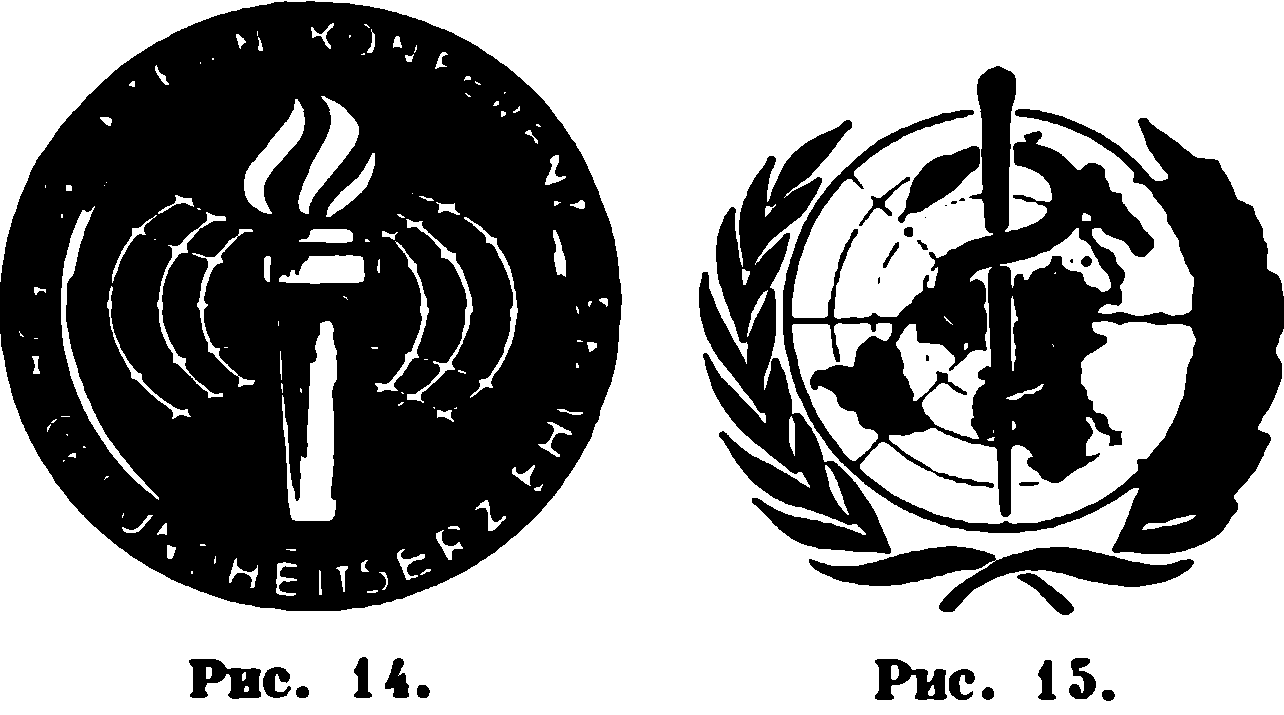
Fig. 14. Commemorative medal of the IV International Conference on Health Education with the image of a burning torch on the background of the globe. Fig. 15. The emblem of the World Health Organization.
Fig. 16. The modern officially adopted in many countries, the emblem of medicine - a stylized image of a staff entwined with a snake (red on a white background).
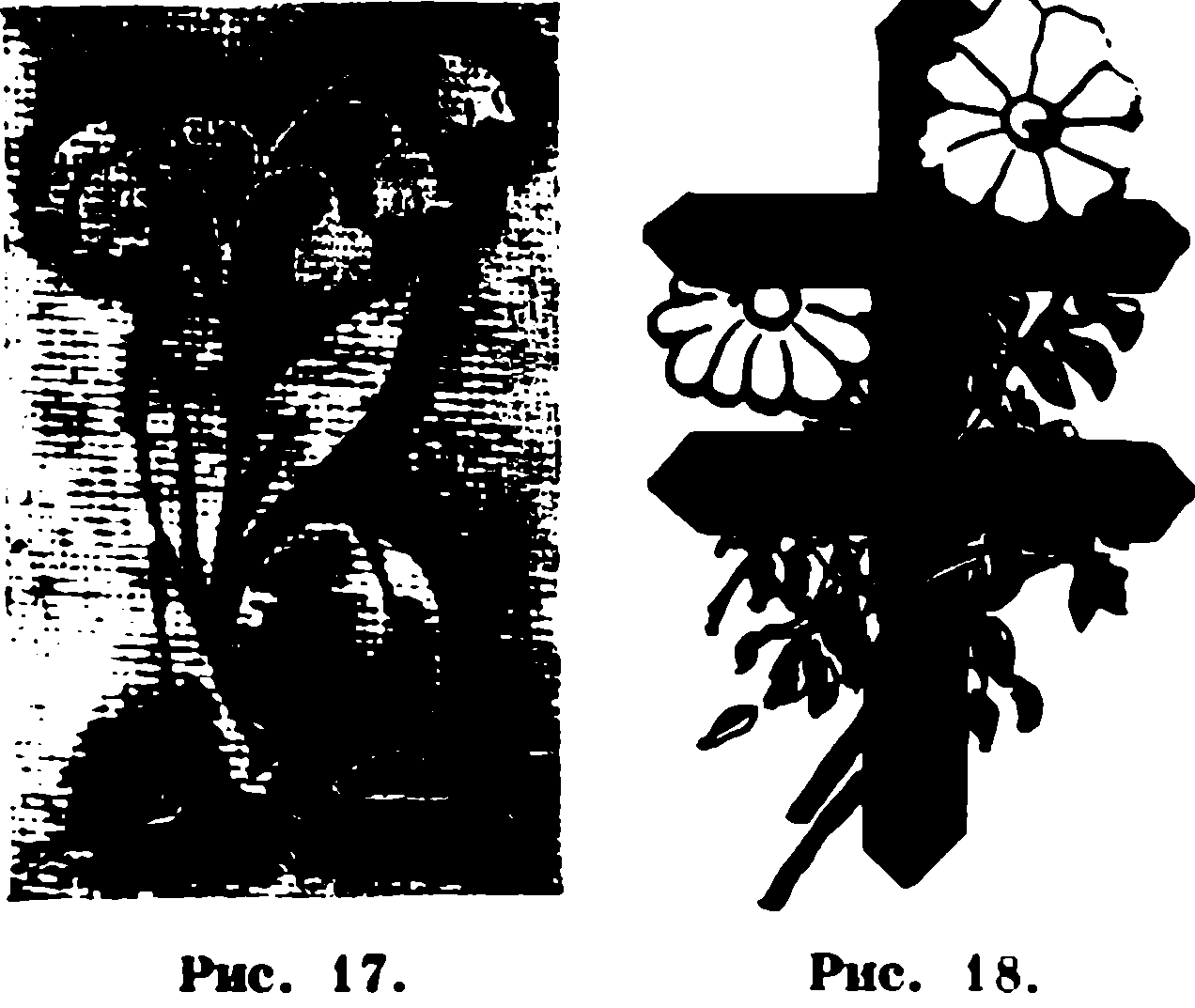
Fig. 17. The image of the lily of the valley - the medieval emblem of therapy (from the title page of one of the first Polish books on internal diseases). Fig. 18. The image of the Lothing cross and white chamomile flowers - emblems of the fight against tuberculosis (a fragment of a postcard issued in Russia before the First World War and spread in favor of tuberculosis patients)
In addition to the general medical emblems, there are many private emblems denoting certain branches of medicine. During the period of medieval medics in Europe were divided into two groups: internists (therapists) and surgeons. One of the most ancient emblems of therapy is the image of a lily-of-the-valley flower, medicines from which were already widely used in the Middle Ages to treat heart diseases (Fig. 1). Other symbols of therapy were images of a urine collection vessel - urinaria (color tab., V. 1, fig. 7), hands, probing a pulse, a rooster, etc. The emblem of the ancient Pythagorean physicians is a pentagram (five-pointed star drawn with intersecting lines ) - in the Middle Ages, the emblem of surgeons became (Fig.19). The symbols of surgery were also images of various surgical instruments (Fig. 22). The emblem of pharmacists who, in the Middle Ages in Europe, united into their guilds separately from therapists and surgeons, were images of various animals (crocodile, rhinoceros, etc.) and plants (lilies), but most often of apothecary mortar and pestle. The emblem of pediatricians in a number of countries (Italy, Russia, etc.) has become an image of a “Florentine baby” - a child swaddled in a belt. For the first time this image was performed by Andreadella Robbia (A. della Robbia, 15th century) on faience medallions decorating the building of an orphanage in Florence (Fig. 20). In Russia, from the 18th century, the emblem of the departments involved in the charity and treatment of children was the image of a pelican. According to medieval tradition, during a drought and famine, a pelican saved his chicks, tearing up his chest and feeding them with his own blood. The image of a pelican along with a drop of blood was used in a number of countries as an emblem of donation (Fig. 23).
The emblem of gerontology is the image of a century tree (Fig. 24). It is possible that the prototype of this emblem is the Hippocrates plane tree - a century-old tree growing on the island of Kos, where Hippocrates lived and worked (color table., Art. 176, fig. 8). The emblem of orthopedics and traumatology is a broken young tree tied to a post (Fig. 25). The emblem of Soviet health care at exhibitions abroad and the emblem of cardiology is the image of the heart in the palm of your hand (Fig. 26). In 1962, WHO offered a special emblem of malaria control - an image on the background of the globe of a spear entwined with a snake and aimed at the malaria mosquito (color plates. Art. 176, Fig. 9). The symbol of the fight against oncological diseases is a crab pierced by an arrow with a sword (color plates., Art. 176, fig. 10).

Figure 19. Publishing sign of the famous German surgeon of the 16th century I. Zoter with a pentagram depicted in it. Fig. 20. "Florentine baby" - the emblem of pediatrics (from the ex-libris owned by the physician).

Fig. 21. The press of the Kiev shop of barbers with the image of various tools. Fig. 22 Medieval seal of the German society of surgeons with the image of instruments, owls (symbol of wisdom) and a snake.
A special place among medical emblems is occupied by symbols of various honey. organizations. Among them, the most widespread is the International Red Cross. In 1864, in Geneva, a convention was signed on improving the fate of the wounded and sick in the existing armies (see Geneva Conventions). This convention has established a distinctive sign of relief societies for the wounded and sick: a red cross on a white field. The four parts of the cross symbolize the four virtues: moderation, prudence, justice, and courage. The prototype of the sign was the national flag of Switzerland (white cross on a red field).
This symbol serves as the emblem of the International Red Cross and most of the national societies of the Red Cross (color tab., Art. 176, fig. 11). The emblem of similar societies in Muslim countries - Afghanistan, Pakistan, Turkey, Iran (since 1980), Arab countries, as well as in Azerbaijan, Tajik, Turkmen and Uzbek SSR - is the red crescent, in Iran until 1980 - the red lion and the sun ( color table, article 176, figure 12). The emblem of the all-Union voluntary mass public organization uniting the Red Cross and Red Crescent Societies of the USSR combines the red cross and the red crescent (see Union of Red Cross and Red Crescent Societies of the USSR).
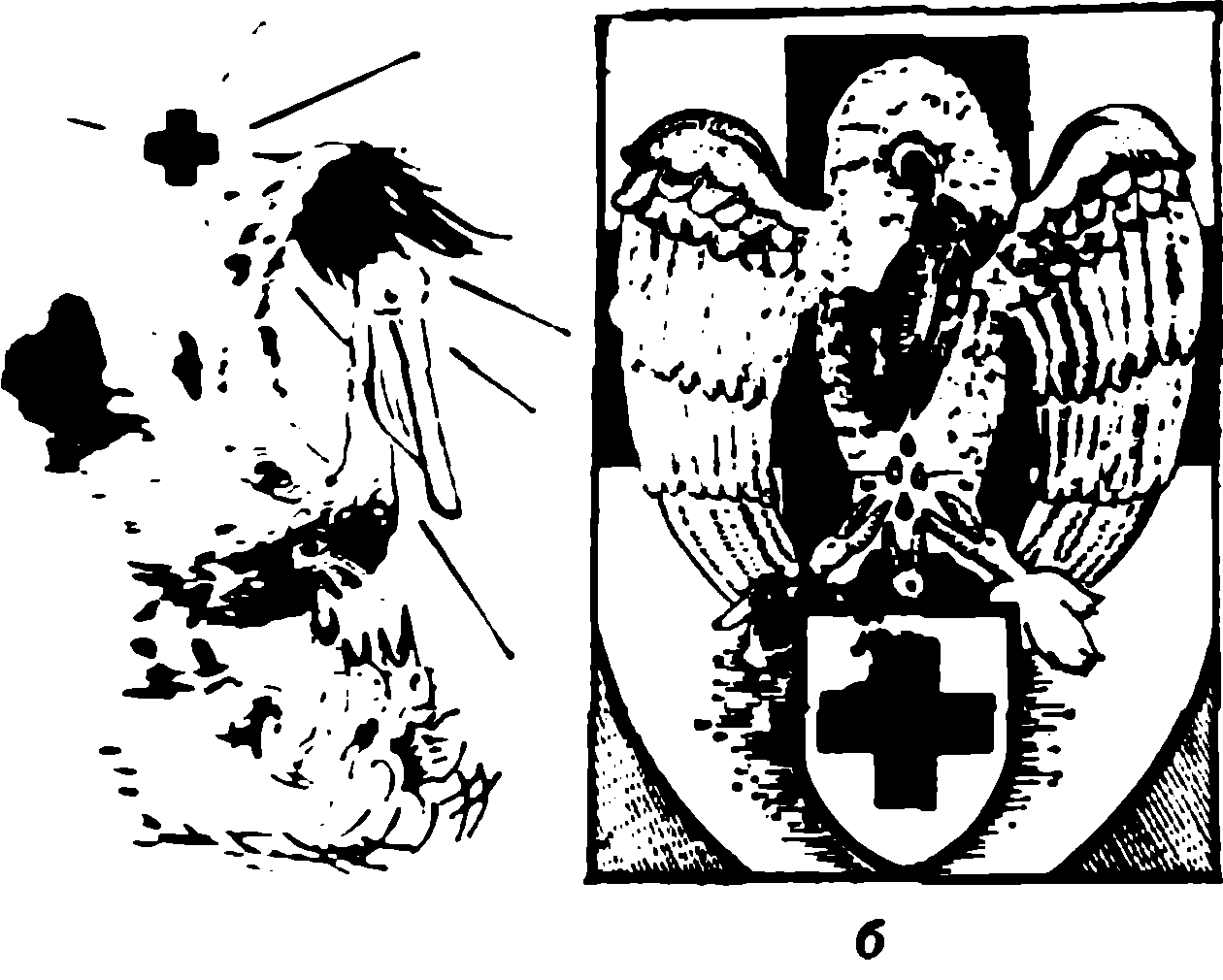
Fig. 27. Foreign emblems of the military medical service.
The tuberculosis organizations took for their distinctive mark images of a Lothing cross (cross with two horizontal lines) and white chamomile (Fig. 18). The International Tuberculosis League at the International Tuberculosis Conference in 1902 (Berlin) approved the red Lorraine Cross as the international emblem of tuberculosis control.
Military medical emblems form a separate group of medical emblems. In most countries of the world, medical insignia in various modifications have been used as insignia of the military medical service (Fig. 27). In some countries, special military medical service marks have been created.
Bibliography: Gribanov E. D. Medicine in numismatics, M., 1962; it, History of the international medical emblems, M., 1976, bibliogr .; Gribanov D.D. and Georgadze V.I. Emblems of Medicine, Tbilisi, 1979, bibliogr .; Zabludovsky P. E. Medical emblem, in the book: From the history of honey .. ed. CG Vasilieva et al., Vol. 5, p. 133, Riga, 1963; Tarasonov. M. Symbols of medicine as a reflection of the healing of ancient peoples, M., 1985; Lipp A. u. Gruber O.V. Die Kerze als Symbol dee Arzttums. Lpz., 1959. Bibliogr .; Schouten J. The rod and the serpent of Asklepios, Symbol of medicine, Amsterdam a. o., 1967, bibliogr; he, The pentagram as a medical symbol; an iconotogical study, Nieuwkoop, 1968.
E. D. Gribanov.
What living creature is associated with medicine? Of course the snake wrapping around the cup. Meanwhile, the poisonous reptile was not always the only medical emblem. There have been and still are many alternative symbols.
Great and terrible
Snake hypostasis of the ancient Egyptian goddess Isis
Snakes have been worshiped at all times and in all corners of the earth. In the myths of Babylon and Assyria, these reptiles reigned in prehistoric times. Snakehead gods were in many pantheons, well, and scaled companion was one of the most frequent satellites of higher powers.
“There is a great serpent; he is the king of the land of Ethiopia; All the rulers bow to him and offer him a beautiful maiden. Having decorated her, they lead this snake before and leave it alone, and this snake devours it ... The length of this snake is 170 cubits, and the thickness is 4; his teeth are as long as his elbow, and his eyes are like a flame of fire, his eyebrows are black as a raven, and the whole look is like tin and copper ... On it is a horn three cubits. When he moves, the noise is heard for seven days' journey. ”
From the Abyssinian legend
Snakes were considered immortal - after all, they are able to periodically shed their skin, that is, be renewed. Many myths agree that this gift was originally intended for people, but either sly reptiles stole it, as in Sumerian legends, or the person himself refused the heavy burden of eternal life in favor of creeping reptiles, as in the Greek myth.
In the ancient world, snakes were very closely intertwined with medicine. So, it was the snake, according to Greek mythology, that suggested the possibility of resurrecting the dead. Once he was invited to the palace of the Cretan ruler of Minos to resurrect the deceased prince. On his staff, Asclepius suddenly saw the serpent and killed it. Immediately another snake appeared with healing herbs in its mouth and resurrected the dead one. The future god took advantage of this grass and raised the dead.
The snake wraps around the body of Isis, the patroness of healing in ancient Egypt, the cobra is one of the hypostasis of the goddess. The same symbol decorated the field kit of the military doctor of the Roman army. On the one hand, people wanted in this way to appease the formidable forces of nature, on the other hand, using the sinister look of a snake, to frighten off diseases.
Fateful vessel

Another component of the traditional medical emblem - the bowl - also has an ancient origin. In the desert terrain it was extremely important to catch the life-giving moisture sent from heaven, and for this purpose large metal bowls were used. It is this holds in the hands, asking for help from the gods, the patient, depicted on the ancient Egyptian stele.
Water was an essential part of any treatment. Healing plots and spells are often cut or minted directly on the vessels. The expressions “the cup of life”, “the cup of patience”, “drink the cup to the bottom”, “the house full cup”, which show how this everyday utensil was important for the ancestors, have survived to this day.
Different bowls carried a different symbolic meaning. For example, a double or a double reflects a human nature’s nature, a positive and a negative, a heavenly and terrestrial component, sublime and base aspirations. That is why in medicine a bowl without a second bottom took root, a Greek phial without a stand. She is often portrayed in the hands of daughters (and according to another version - and wives in general) of Asclepius - Hygiea and Panakei.

The bowl is also directly related to snakes: their poison was collected and stored mainly in such dishes. It also mixed teriaki - ancient and medieval universal antidotes. Up until the 20th century, pharmacists used copper or brass bowls.
One of the rare variants of the emblem is a snake wrapped around the handle of the mirror. It protects the surface of human consciousness, which keeps reflections of previous millennia. Apparently, therefore, the International Society for the History of Medicine chose such an unusual symbol for itself in 1980.
The symbol, but not the one

If you look closely at the emblem of the World Health Organization, which was approved at the I Assembly in Geneva in 1948, you will notice that there is not a cup around the snake, but a staff. Why did it happen? Where did this attribute come from?
This is the staff of Asclepius. The one with whom one serpent was killed and onto which the second climbed, who came to resurrect it. This symbol contains a large number of other values. For example, it is most often depicted as a gnarled stick, which means communication with the earth and nature. In addition, the staff is a symbol of wandering, namely, in traveling, ancient doctors acquired their knowledge and skills. In addition, if the doctor relied on something while walking, it means that he was wise not only for years, but also for experience. And it was precisely such a doctor that was trusted the most.
In the Middle Ages and in the Renaissance, the staff transformed into a medical cane, and in some cases into a medical sword, which, for example, was in Paracelsus. Often in the upper part there was a secret medicine, a unique antidote, or simply vinegar, used to prevent infection from the patient. The tradition disappeared only by the middle of the 20th century, and the staff became a symbol of medicine in Europe.

By the way, on the staff of Asclepius there can be not one serpent, but two. But the story of another emblem is much more interesting, when the staff is shorter, the snakes are always two, and there are still wings at the top. Caduceus, the staff of the heralds, as well as the indispensable tool of the god Hermes (Mercury), capable of reconciling even the most ardent opponents. The common medical symbol of caduceus became in the Renaissance.
There is a version, this is due to the fact that in the XVI century alchemy began to develop, the patron saint of which was considered Hermes. The main goal of alchemical experiments at that time was no longer the search for a philosopher's stone, but the obtaining of medicines. On vessels with drugs, alchemists usually stamped with Hermes. As an emblem of doctors, caduceus was entrenched, for example, in the United States of America. But there is another version: the caduceus was simply mistaken for Asclepius’s another staff, since they are similar. Is there anything wrong fixed in our lives? Here is the rod of Hermes - approximately from the same opera.

Well, the classic snake with a cup caught on mainly in the territory of the former USSR. In modern Russia, it was not without modifications, for example, on the current emblem of the Military Medical Academy, two snakes are shown twisting the bowl in opposition to each other (see figure above).
Other

Asclepius and rooster. Statue of Asclepius with a dog lying at his feet in Asklepione
For a long time, owl, rooster, raven, and dog were considered to be full and equal symbols of medicine. All of them at different times depicted next to Asclepius. The owl and the raven were considered a symbol of wisdom, without which the doctor can not do. The dog is the personification of loyalty and devotion, the desire to serve and protect. The raven from this company lasted the longest, medieval alchemists tagged him with their medications.
An interesting interpretation of the role of the rooster: first of all, he was just a sacrificial food, his blood was intended for Asclepius, and the meat, to which the healing properties were attributed, was sick. With the advent of Christianity, another interpretation emerged: the rooster’s cry chases away the evil spirits, welcomes the coming of the morning, when it becomes easier for most patients.
“How pleasant is the song of the rooster at night. And not only pleasant, but also useful. Everybody gives hope in the heart of this cry; patients feel relieved, pain in wounds is reduced: with the advent of light the fever heat subsides "
Ambrose of Milan (III cent.)
Often the rooster was depicted paired with a snake, in this case they personified two key qualities of the doctor: vigilance and caution. Sometimes on ancient bas-reliefs Asclepius is accompanied by a goat. Her image recalls that, according to Greek mythology, the goat Athena fed Asclepius the baby with milk. That is why in asclepion usually bulls, pigs and rams were sacrificed, but goats were never among the sacrificial animals.
In the 13th century, the images of a staff with a snake and a singing rooster were decorated with the title pages of medical writings. In the Renaissance, medicine was often depicted as a woman (presumably - Hygiea), topped with laurels. In one hand was her staff, entwined with a snake, and in the other - a rooster.
Crosses and stars
 The red cross and the blue six-pointed star can be considered as a modern addition to the arsenal of medical paraphernalia. I think everyone knows the history of the first symbol, so let me remind you only briefly: in 1863, a committee to reduce the suffering of soldiers during wars was created in Geneva, the participants of the founding conference chose the inverted flag of Switzerland as an emblem, without thinking twice. The red cross, originally associated only with the ICRC, got accustomed and became, perhaps, the most common designation of everything medical: it is on specialized medical machines, on the doors of medical institutions, even on first-aid kits in computer games, and a lot more on it.
The red cross and the blue six-pointed star can be considered as a modern addition to the arsenal of medical paraphernalia. I think everyone knows the history of the first symbol, so let me remind you only briefly: in 1863, a committee to reduce the suffering of soldiers during wars was created in Geneva, the participants of the founding conference chose the inverted flag of Switzerland as an emblem, without thinking twice. The red cross, originally associated only with the ICRC, got accustomed and became, perhaps, the most common designation of everything medical: it is on specialized medical machines, on the doors of medical institutions, even on first-aid kits in computer games, and a lot more on it.
However, this is slightly altogether wrong in terms of law. The red cross is an official and protected image, belongs only to the ICRC, and it is used exclusively in wartime. It can be worn by military doctors, military priests, they are marked with means to care for the wounded, including hospital tents, and it is also used to designate an international or national representative of the organization. And that's all. The ICRC, through national committees, is trying to sensitize organizations and people using the red cross to the right and left, sometimes it even reaches the court, so Johnson & Johnson once forcibly took away the red cross trademark.
However, this legal collision has a downside: the protected image is a red cross on a white background. If you change the background or cross color - everything, take who you want, use where you want. So a green cross of pharmacists, a blue cross of veterinarians, etc. appeared. By and large, even the classic red cross, but on a blue, yellow, purple, any other background, is already quite a legal logo.
A very short lyrical digression: if absolutely correct, then the red (though not only red) crosses painted on their clothes the Templar and the Hospitallers, and it is to the latter that we owe to the appearance of the hospitals. Initially, they were peculiar shelters, hotels or something, but gradually they began to talk about the military (first), and then about civilian hospitals. Another thing is that the hospital crosses were different from the Swiss ones, which the ICRC took for itself, but this is a completely different story.
 During the Russian-Turkish war (1876-1878), another official symbol appeared - the red crescent, an option for Muslim countries. The Israelis tried to promote the red Mogend, but the ICRC did not like this idea. After long disputes in 2005, a special ICRC symbol, a red crystal, an equilateral diamond on a white background, was adopted at a special conference by two thirds of the votes.
During the Russian-Turkish war (1876-1878), another official symbol appeared - the red crescent, an option for Muslim countries. The Israelis tried to promote the red Mogend, but the ICRC did not like this idea. After long disputes in 2005, a special ICRC symbol, a red crystal, an equilateral diamond on a white background, was adopted at a special conference by two thirds of the votes.
 The fact is that by that time there was a huge mass of applications for international recognition of national and / or religious emblems in red: here is the Siamese red flame, and the Persian red sun, and the red wheel with a swastika, and the red Lebanese cedar, and the red Sudanese rhino , and the red Syrian palm and even the red star claimed from Zimbabwe. The ICRC considered that such diversity destroys the very idea of a universal single symbol, which can be used as a guardian in any war. Three will suffice, the ICRC said: the cross is for Christians, the crescent is for Muslims, the rest will be killed by crystal, there is nothing for the essence to multiply.
The fact is that by that time there was a huge mass of applications for international recognition of national and / or religious emblems in red: here is the Siamese red flame, and the Persian red sun, and the red wheel with a swastika, and the red Lebanese cedar, and the red Sudanese rhino , and the red Syrian palm and even the red star claimed from Zimbabwe. The ICRC considered that such diversity destroys the very idea of a universal single symbol, which can be used as a guardian in any war. Three will suffice, the ICRC said: the cross is for Christians, the crescent is for Muslims, the rest will be killed by crystal, there is nothing for the essence to multiply.
The MOE nicknames swallowed the pill, took off the crosses, and in their place put a blue star about six rays, and these rays are the main tasks that rescuers and paramedics solve: detection, communication with experts, response, assistance in the field, transportation assistance, delivery in hospitals. The star was patented in 1977, the logo of the American Medical Association was taken as the basis for its development. In 1997, the term of patent protection expired, and today very many “Ambulances” around the world carry the “Star of Life” on their boards - from Peru to Poland and from Sweden to Italy. It is noteworthy that inside the blue star there is a regular staff, classic, long, with one snake and without wings.
P.S. I do not pretend to comprehensive coverage, it is possible that I missed something important.
A strongly abbreviated version of the article was published in the journal Russian Pharmacies, 2013, No. 24
The common medical emblems can include various images of a snake, incl. in combination with a staff, with a bowl, with a candle, etc., images of a burning torch, a lamp, hearts in the palm. The most widespread emblems with the image of a snake.
In primitive society, when totemism and animalism evolved, reflecting the helplessness of primitive man to the outside world, the serpent was one of the main totem animals. With the emergence of the serpent cult, she was attributed a double role: evil and good. On the one hand, the snake was a symbol of cunning and deceit, on the other - immortality, wisdom and knowledge.
In the ancient world, medicine was symbolized not by a poisonous snake, but by a harmless one. Records of ancient medical authors indicate that snakes were crawling around the house during the "holy sleep", often licked sore spots - eyes, wounds. The Romans kept them in the baths and baths. It is believed that in some countries of Europe the Eskulap's snake came due to the Roman conquerors.
It is possible to explain in different ways that many peoples have long linked snakes with healing the sick.
Some researchers believe that diseases, and even more death, have always been mysterious and incomprehensible to people. The causes of illness and death were also incomprehensible. The snake, too, always remained a mysterious and incomprehensible creature. Perhaps, researchers believe, people associate incomprehensible phenomena with incomprehensible creatures.
It is assumed that, as a emblem of healing, the snake symbol was first used around the 2nd millennium BC in Ancient Babylon, where animal worship remained in the era of slavery.
On the one hand, the snake was a symbol of cunning and deceit, on the other - immortality, wisdom and knowledge. As the emblem of medicine, the original snake was depicted without any attributes.
Later images of a snake appeared in combination with various objects. So, from about 8 in. BC. one of the symbols of medicine is staff of the god of healing Asclepius (Esculapius) - a blunt stick, around which a snake has stuck its head up.
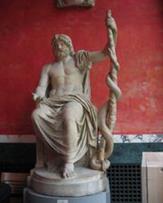
In one of the ancient Greek myths, it is said that Asclepius was invited to the palace of Minos, the king of Crete, to resurrect his deceased son. On the way, he saw a snake on his staff and killed her, but another snake appeared with healing herbs in its mouth and resurrected the dead one. Subsequently, Asclepius cured sick people with this grass.
This legend explains why, in most cases, Asclepius is depicted standing, in a long cloak, holding a staff entwined with a snake. His figure was the first international emblem of medicine.
Currently, the upright staff, entwined with a snake, depicted against a background bordered with laurel branches of the globe, is emblem of the World Health Organization (WHO) to the United Nations.

This emblem was adopted at the I World Health Assembly in Geneva (1948) and consists of two emblems: the UN emblem (the globe in the frame of laurel branches) and the emblem of medicine (a staff entwined with a snake). The symbolism of this emblem reflects the domination of medicine over the healing, life-protecting forces of nature.
The staff of Asclepius should not be confused with caduceus ("The sign of authority of the messenger") - an attribute of the Greek god of commerce Hermes (from the Romans Mercury).
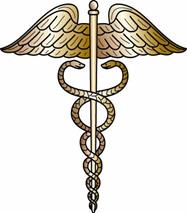
It is a symbol of balanced and virtuous behavior, which is a rod with wings at the top, entwined with two snakes. In Roman mythology, Mercury used a rod to reconcile two fighting snakes.
The Rod entwined with two snakes combines several fundamental symbolic elements at once: the central core symbolizes the Tree of Life (in the meaning of the connection between heaven and earth): the double helix formed by snakes is a symbol of cosmic energy, duality, and the unity of opposites; the snakes themselves are the fruitful powers of the earthly and otherworldly worlds. In the ancient world, this emblem was not medical. Only 15-16 centuries. caduceus has become a symbol of medicine. From the 19th century Caduceus is used as the official medical emblem in a number of countries in America (for example, the USA), Africa and Asia.
The association with medicine was due to the presence of a serpent in a caduceus — as in the staff of Esculapius. The famous psychologist Carl Jung considered caduceus to be the emblem of homeopathic medicine - the snake means both poison and a therapeutic drug.
Caduceus began to be used as a sign to protect the secret of commercial or political correspondence. Currently, it is the emblem of medicine or commerce.
First images bowls with a snake relate to 800–600 BC. The snake and the bowl were depicted separately and were attributes of the main goddess of health, Hygiea, who was usually depicted with a snake in one hand and with a bowl in the other.

Images amphoras or snake-shaped bowls appeared much later.

An exact and legalized symbol of medicine in the form of a snake, wrapped around a bowl or depicted next to it, neither in ancient times, nor much later.
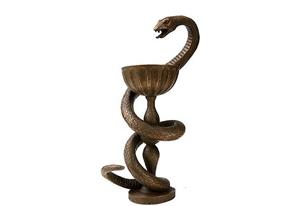
According to Academician E.N. Pavlovsky, a bowl with a snake as a symbol of medicine appeared only in the 16th century thanks to the famous doctor Paracelsus, who first proposed this combination instead of the traditional caduceus at that time. In the ancient world, the emblem of medicine was not a poisonous snake, but a harmless one.
It is possible that this emblem personifies the healing properties of snake venom, so widely used in medicine, and means the vessel where the snake venom was stored. The snake symbolizes wisdom, knowledge, immortality, and in general all the good things started.
One of the first Russian medical historians who turned to the analysis of the contents of the symbol of a cup entwined with a snake was F. R. Borodulin. He said: “We tend to view this emblem as a reminder to the doctor about the need to be wise, and to draw wisdom from the cup of the knowledge of nature.” That is, in our time, the cup in the medical emblem is defined by him as the cup of the human mind, encompassing the whole world.
In ancient mythology, the gods drank a drink of immortality from a cup. Therefore, the cup in the medical emblem can be interpreted as a symbol of the healing forces of nature in general.
In Russia, this emblem called “Hippocratic Cup” became the main medical symbol in the XVIII century.
As a difference in the medical service in the army, a bowl with a snake was introduced under Peter 1. The snake wrapped around the leg of the bowl and bent its head over the bowl as a symbol of military medicine was approved in the USSR in 1924. This badge is preserved in Russia so far as the official emblem of the military medical staff of all the armed forces.
The most common is the use of the emblem in the form of a bowl with a snake for pharmaceutical activity.
Known medicine emblem in the form of the Apollo tripod entwined with a snake.
In Europe (France, Belgium, Greece, etc.) from the 18th century. there was a medical emblem in the form of a mirror entwined with a snake . The mirror is a classic symbol of purity and care - the qualities required by the doctor, but since the mirror is also a roskash symbol, to avoid confusion, they began to portray it as a symbol of caution along with the snake - the most careful animal.

Along with the emblems of healing, on which the snake was depicted, from ancient times there were others.
The ancient Egyptian god of healing Imhotep (coming in peace) was depicted with cruciform loop in the hands - the so-called ankom Imhotepa. This symbol denotes well-being, life and health. Later it was known under the name "tau - cross" (the image of the Greek letter "tau" was used as an amulet).

There are medical emblems in the form burning torch or lamp (later candles).

The fire, according to the teachings of Heraclitus of Ephesus (6–5 centuries BC), was considered in medicine as the most extreme, all healing remedy, which was addressed in the case of failure of medical and surgical treatment. By the end of the Middle Ages, the antique torch in the images was replaced by a candle due to the fact that the candle was a religious attribute. The image of the candle was accompanied by the dictum: “When shining for others, I burn,” “By serving others, I destroy myself,” etc.
Currently, a burning torch is the emblem of health education.
Private emblems.
Private emblems denote one or another branch of medicine. During the Middle Ages in Europe therapy emblem It was the image of a flower of lily of the valley, from which medications were already widely used in the Middle Ages to treat heart disease. Other symbols of therapy were images of a urine collection vessel - urinaria, hands probing pulse, etc.
Symbols of surgeryserved images of various surgical instruments.
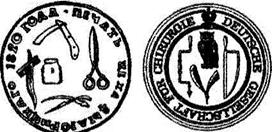
Emblem cardiology is the image of the heart in the palm. The emblem very accurately reflects its content - respect for the heart.
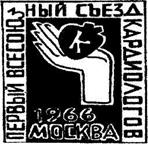
Emblem pharmacists there were images of various animals (crocodile, rhinoceros, etc.) and plants (lilies), but most often - an apothecary mortar and pestle.

During the XVIII and especially the XIX century. The snake wrapped around either the cup of Hygiea or the staff of Asclepius became the emblem of pharmacy in all European countries. The combination of the images of the serpent of Asclepius and the cup of Hygiea on the emblem was suggested by apothecaries of Padua.
Emblem of pediatrics in a number of countries (Italy, Russia, England, etc.) there was an image of the "Florentine baby".
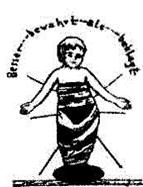
This image was first performed by Andrea Della Robbia (15th century) on faience medallions adorning the building of an orphanage in Florence.
In Russia since the 18th century the emblem of the departments engaged in charity, the teachings of children, was the image of a pelican. According to medieval tradition, during a drought and famine, a pelican saved his chicks, tearing up his chest and feeding them with his own blood.
The image of the pelican along with a drop of blood was used in a number of countries as donation emblems.
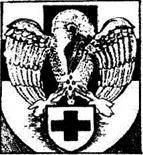
Emblem of gerontology The image of a century tree serves.
It is possible that the prototype of this emblem is Hippocrates' plane tree - a century-old tree growing on the island of Kos, where Hippocrates lived.

Emblem of Orthopedics and Traumatology - a broken young tree tied to a post.
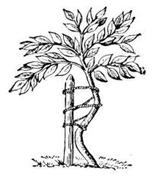
A special place among medical emblems is occupied by symbols of various medical organizations.
Red cross and red crescent on a white field are among the few signs that people around the world easily recognize. Originally created to designate the sanitary services of the armed forces and provide protection for the sick and wounded, they gradually became symbols of impartial humanitarian assistance provided to all those who suffer.
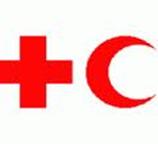
These symbols do not mean "all medical." These symbols are the official emblems of the International Red Cross and Red Crescent Movement.
The initiator of the creation of the Movement in the 19th century. became the Swiss Henri Dunant. Impressed by what he saw in one of the battles of the Franco-Austrian war, he published an article in which he asked the question: Is it possible to create a voluntary charitable organization that provides assistance to the wounded during wars and armed conflicts?
The Geneva Charity of the Union for the Preservation of Public Benefit established the International Committee of the Red Cross (ICRC).
The first meeting of the ICRC took place on February 17, 1863 in Switzerland. In tribute to the country that historically retained neutrality towards the warring parties, and organized the first Geneva International Conference in 1863, the emblem was based on the national flag of Switzerland with a conversion of federal colors, that is, a red cross on a white background. The four parts of the cross symbolize the four virtues: moderation, prudence, justice, and courage.
During the Eastern Crisis (1875–1878) and the Russian-Turkish War (1877–1878), the Ottoman Empire allowed the Red Cross to operate on its territory, however, obliging the ICRC to change its symbolism to the Red Crescent.
Since then, in most Islamic countries, the red crescent has played the same role, and in Iran, the red lion and the sun.
According to the Geneva Conventions of 1949, the emblem of the Red Cross is given to humanitarian and medical transports, buildings, convoys and missions in order to protect them from attacks from conflicting parties. Only the medical service of the army of the State party to the Geneva Conventions is entitled to use it. These emblems are depicted on the roofs and sides of buildings, on the hoods and doors of military vehicles, on tents and other objects where wounded and sick soldiers, military doctors, as well as affected civilians are located.
You can not acquire a license to use these emblems, even for the most noble purposes. The most common violation in the use of the emblem in peacetime is considered to be imitation, that is, the use of a sign, which in shape or color can be associated with a red cross. Misappropriation of the right to use the emblem: it is a question of the use of the emblem by organizations or persons not entitled to it.
Each State party to the Geneva Conventions is obliged to take measures aimed at preventing and combating abuses of the use of the emblem. Therefore, the authorities of many countries, including the CIS countries, on the recommendation of the ICRC, have adopted laws restricting the use of the official ICRC emblem. The official emblem of this organization should be used as a symbol of salvation during hostilities, emergencies, so that the emblem does not become something ordinary. In Belarus and Ukraine, for example, a red cross on a white background can be used on the machines of the medical service of the armed forces, on the machines of the medical service of the internal troops, on the transport of the Ministry of Emergency Situations.
Tuberculosis organizations they took for their distinctive mark the image of the Lorraine cross and white chamomile.
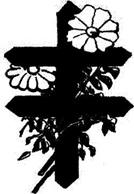
International tuberculosis league at the international tuberculosis conference in 1902 (Berlin) approved the image of the Lorraining cross and white chamomile.
In 1962, WHO proposed a special malaria emblem- The image on the background of the globe spears entwined with a snake and directed at the anopheles mosquito.

Postage stamp with the emblem of the fight against malaria.
The emblem of the fight against cancer - crab pierced by an arrow or sword.

Postage stamp (Netherlands) with the emblem of anti-cancer control.
New Articles
- What is the highest peak of the Ural Mountains
- The most ancient religions in the world
- What continents are washed by the Atlantic Ocean?
- Can I wear jewelry of the deceased?
- Snake, Bowl and Staff: The Origin of Medical Symbols
- Interesting facts about hares
- Names of famous brands in other countries
- Karelo Finnish epic kalevala protagonists
- 17 18 weeks pregnant sensations
- Why do people become so aggressive
Popular articles
- Expression twice in one river, meaning and meaning
- Gusli - musical instruments
- Report: Temperature Scales and Thermometers
- Which side to sew on chevron
- How to draw emblems for school
- Unusual rivers of the world and the rivers of Russia - Rivers with sour water
- Numb of the little finger on the right hand: causes and methods of treatment
- Why development is important for a person
- Constellations from ancient atlases
- What happens at 31 weeks
